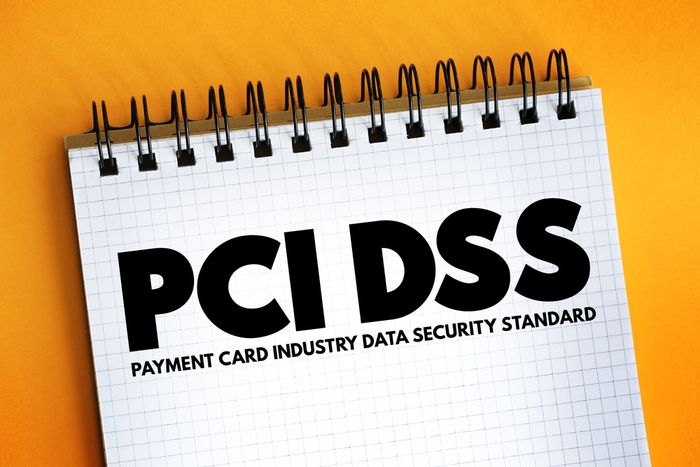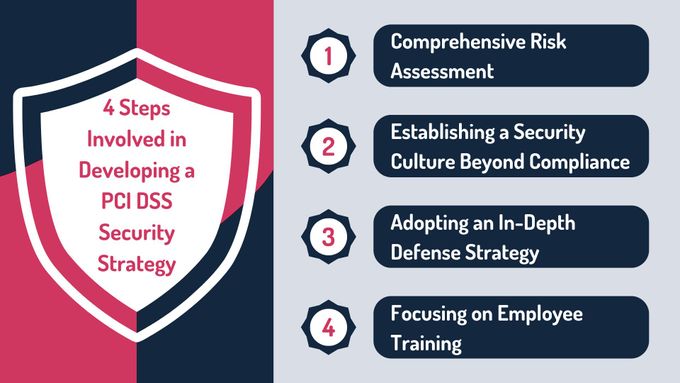How to Build a Robust PCI DSS Security Strategy: Beyond Compliance
Move beyond the basics of PCI DSS compliance and discover how to strengthen your data security with proven solutions.
Published April 5, 2025.

As organizations work to meet PCI DSS requirements, simply maintaining good compliance isn’t enough to protect sensitive data against today’s sophisticated cyberattacks. While PCI DSS sets a basic security foundation, modern threats demand a more proactive approach. Relying only on compliance may leave you vulnerable to risks beyond the standard's scope.
To build a robust security strategy, you must move beyond basic compliance and tackle a broad range of risks. This enhances your defenses and boosts customer trust by showing a commitment to data protection.
» Discover how GRSee can enhance your enterprise security with continuous compliance monitoring
Foundational Elements of a Strong PCI DSS Security Strategy
Implementing robust security measures across various layers can help preserve security and protect sensitive data. A strong PCI DSS security strategy involves comprehensive protection, addressing multiple areas to ensure data remains secure from every angle:
- Network security: Segmentation and firewalls are essential to limit access to sensitive data. Network security prevents unauthorized access to critical systems and reduces the risk of external threats.
- Data encryption: Encrypting cardholder data at rest and in transit is essential to ensure that attackers cannot access it even in the event of a breach. This involves implementing strong encryption protocols and securely storing encryption keys.
- Access control and authentication: Restricting access to sensitive data is crucial, allowing only authorized personnel to handle sensitive information. Implementing multi-factor authentication (MFA) and strong password policies helps prevent unauthorized access.
- Vulnerability management: Regular vulnerability assessments and patching schedules are essential to maintaining a secure environment. Organizations need to identify, assess, and mitigate potential vulnerabilities before they are exploited.
- Monitoring and logging: Continuous monitoring of systems and maintaining logs of all access to sensitive information ensures that suspicious activities are identified in real-time. This provides a crucial layer of detection and response to potential security incidents.
- Physical security: Protecting the physical infrastructure that stores and processes sensitive data is just as important as digital security. Access to servers, data centers, and other physical components must be tightly controlled to prevent unauthorized entry or tampering.
» Find out more about foundational factors towards PCI DSS compliance
Role of Employee Training and Awareness
The human element is often the weakest link in any security strategy. While technical controls are essential, the role of employee training and awareness cannot be understated.
Employee Training Programs
Effective employee training programs incorporate practical simulations—such as phishing, smishing, and vishing exercises—to prepare employees for real-world threats and create a secure development lifecycle.
- Phishing tests employees' ability to recognize malicious emails.
- Smishing focuses on deceptive text messages.
- Vishing, involving fraudulent phone calls, addresses the growing use of social engineering tactics across communication channels.
Role-based training ensures that each employee understands the specific risks tied to their job functions. For example, IT teams may focus on managing access controls, while customer service teams learn to safeguard personal information during interactions. Tailored training programs ensure employees can mitigate role-specific security risks, thereby strengthening the overall security culture.
» GRSee can support your efforts to strengthen your security by leveraging penetration testing and training in PCI DSS
Case Studies: Employee Training for Security Risks
Example #1: Target
In 2013, Target suffered a major data breach due to poor internal training and awareness. The breach compromised over 40 million credit card numbers, leading to an estimated cost of $200 million.
Example #2: Alibaba
In November 2019, Alibaba experienced a data scraping incident where over 1.1 billion pieces of user data were compromised. A developer created software to scrape usernames and mobile numbers from Alibaba's Taobao website over an eight-month period. While the information wasn’t sold on the black market, both the developer and their employer were sentenced to three years in prison.
Example #3: LinkedIn
In June 2021, LinkedIn faced a data scraping event that affected 700 million users. A hacker exploited LinkedIn's API, gathering personal data such as email addresses and phone numbers. Although LinkedIn argued this was a violation of terms of service rather than a breach, the exposed data left users vulnerable to social engineering attacks.
4 Steps Involved in Developing a PCI DSS Security Strategy
A well-rounded PCI DSS security strategy addresses both technical and human elements of security, ensuring that your organization is prepared to handle evolving threats. Here are the essential steps involved in building such a strategy:
1. Comprehensive Risk Assessment
The first step in creating a PCI DSS strategy is to conduct a thorough risk assessment. This involves identifying potential security gaps and vulnerabilities in your payment systems, network infrastructure, and data storage methods. Risk assessments highlight compliance gaps and help prioritize resources to address critical vulnerabilities.
2. Establishing a Security Culture Beyond Compliance
It's essential to move beyond simply meeting the requirements and focus on establishing a security-focused culture within your organization. This involves integrating security into daily operations and decision-making processes at all levels. In this regard, building a security-first mindset ensures that everyone, from executives to frontline employees, views protecting sensitive data as a key responsibility.
» Explore the standards you should meet when building a security culture
3. Adopting an In-Depth Defense Strategy
Layered security controls, such as firewalls, intrusion detection systems, and encryption, should be part of an in-depth defense strategy. By having multiple layers of protection, organizations can reduce the likelihood of breaches and ensure that sensitive data remains secure, even if one security layer is compromised. Regularly updating these measures and ensuring they are aligned with the latest threats is crucial for ongoing protection.
» Work in Fintech? Consider PCI-DSS as a baseline
4. Focusing on Employee Training
Employees play a critical role in the success of any PCI DSS strategy. Investing in continuous, role-based security training empowers staff to recognize threats and handle sensitive data responsibly. Training programs should cover both general security principles and specific risks related to each employee's role, reinforcing the importance of data security throughout the organization.
Best Practices for Handling Sensitive Data
Many of the practices for handling sensitive data are similar to the foundational elements of a strong PCI DSS security strategy, such as data encryption and access controls, along with other specific strategies like utilizing multi-factor authentication (MFA).
Here are some other things to keep in mind:
Disposing of Sensitive Data
Properly disposing of sensitive data is crucial for maintaining PCI DSS compliance.
Data should be deleted according to your organization's SLA and retention policy. Automating the deletion process helps ensure consistency and reduces the risk of human error, particularly for soft data. You should implement systems that track expiration dates and automatically remove data when it is no longer needed.
For physical destruction, it's essential to use a cross-cut shredder for documents, CDs, or other media, ensuring the data cannot be reconstructed. Maintaining a destruction log adds accountability, ensuring sensitive information is securely destroyed and unrecoverable.
Working With Third Parties
When handling sensitive data, ensuring that third-party vendors comply with PCI DSS requirements is critical. Establish clear security expectations and regularly audit vendors to ensure they maintain the same security standards. Contracts should explicitly outline data handling protocols, encryption standards, and breach response procedures to minimize risks when working with external partners.
5 Key Practices to Strengthen Data Transmission Security
1. Multi-Factor Authentication (MFA)
MFA adds an additional layer of security by requiring users to verify their identity using two or more verification factors before accessing sensitive data. With MFA, you reduce the risk of unauthorized access even if passwords are compromised.
2. Use a VPN
Using a virtual private network (VPN) ensures that data transmitted between remote locations and the corporate network is encrypted. VPNs are especially important when accessing company resources over public or unsecured networks, helping to prevent interception by unauthorized users.
3. Implement a Robust Access Control Policy
Enforcing strict access control policies ensures that only authorized personnel can access sensitive data during transmission. Limiting data access to those who require it minimizes the risk of internal and external threats, providing stronger data protection.
4. Strong Wi-Fi Encryption
Securing wireless networks with WPA3 or similar encryption standards is crucial to protecting data in transit. Weak or outdated encryption protocols like WEP can be easily compromised, making strong Wi-Fi encryption a foundational aspect of securing network transmissions.
5. TLS Transmission
Transport layer security (TLS) is essential for encrypting data during transmission between systems. It prevents unauthorized entities from intercepting and tampering with data, ensuring secure communication channels between servers and applications.
» Make sure you avoid these PCI-DSS pitfalls
Continuous Monitoring: A Proactive Approach to Security
To stay ahead of evolving threats, you should also look into implementing continuous monitoring and improvement protocols as part of your PCI DSS security strategy. Leveraging tools like security information and event management (SIEM) systems allow for the collection and analysis of real-time data from firewalls, networks, and servers.
SIEM tools help automate log analysis, flagging suspicious activities that would be impossible to track manually. Open-source solutions like OSSEC and Wazuh offer mini-SIEM functionalities, centralizing logs and detecting threats in real-time.
Beyond real-time monitoring, you should regularly conduct vulnerability scans, apply patches, and keep systems updated to mitigate new risks. These proactive steps ensure that security gaps are closed before they can be exploited. Continuous monitoring is not just about compliance, it's a key defense mechanism that helps you quickly identify and respond to threats while maintaining a secure environment.
How GRSee Helps Organizations Build a Robust PCI DSS Strategy
At GRSee, our approach to PCI DSS compliance goes far beyond just helping organizations pass audits. We provide:
- Gap assessments: A detailed evaluation of your current state of compliance.
- Guidance: Expert assistance throughout the entire compliance process.
- Customization: Tailored solutions to fit your specific environment.
- Scope reduction: Minimizing the scope of your PCI environment to reduce risk.
- Enhanced security: Implementing robust security controls for overall data protection.
- Continuous support: Ongoing assistance to maintain compliance year-round.
- Version transition: Guidance on transitioning to new PCI DSS versions.
- Post-compliance support: Ongoing services to ensure continued compliance.
We offer comprehensive PCI DSS compliance services. From initial assessment to ongoing support, we help you achieve and maintain compliance, reduce risk, and enhance data security.
» Get started with GRSee’s PCI DSS solutions to simplify your security strategy!





